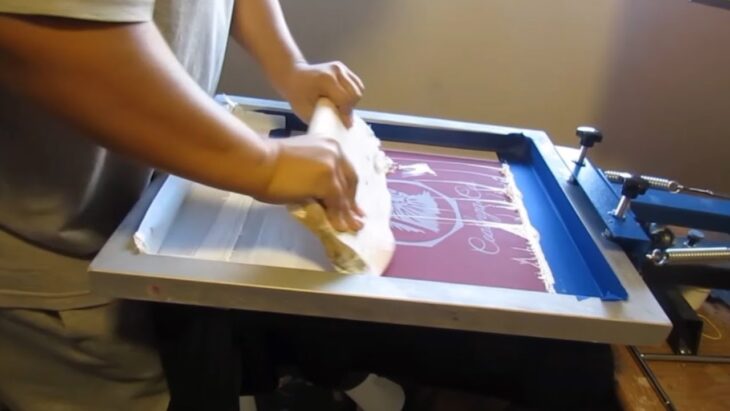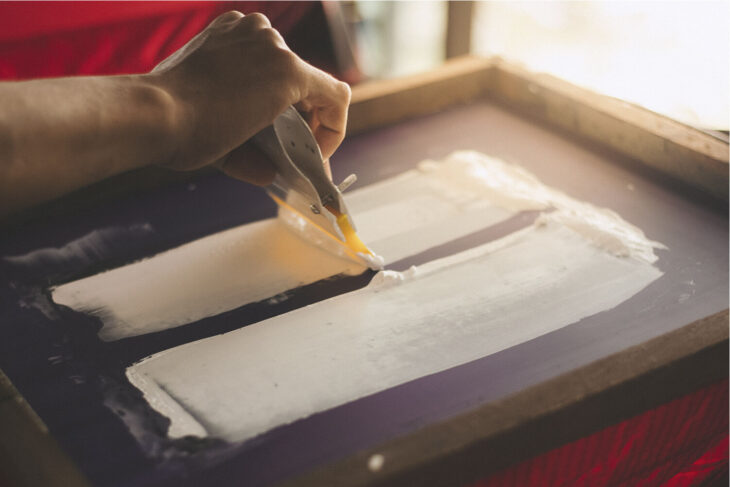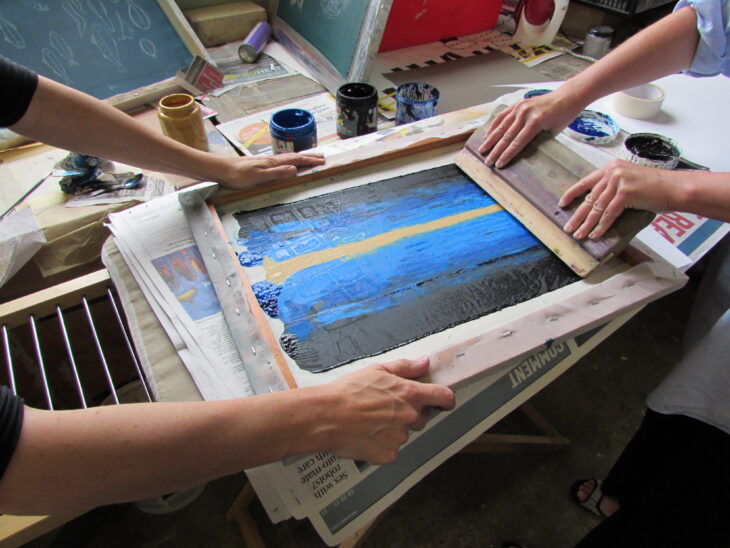The corona crisis makes us humans creative. Many people suddenly have more time than ever before because of a home office or little to no work, can hardly leave the house, shopping is no fun with a face mask (if you are lucky enough and are allowed to leave the house at all) and you are not allowed to meet friends anyway.
It’s no wonder that everyone wants to try DIY now. Social media like Instagram is full of posts with beautiful, homemade artwork, the latest recipe ideas, delicious cake or fresh, homemade bread.
But what if you just don’t like being in the kitchen? Still, you can and should let off steam creatively and discover some new techniques that are really fun. An example for all those who like to work with their hands and experiment with colours and shapes: silkscreen printing is a great way to dive deep into a creative, fun craft.
Contents
What is screen printing actually?

Source: sitografika
The experts for textile printing at Paniho Shirt put it in a nutshell: Screen printing is one of the oldest methods for textile printing and provides clear, vivid colours and flawless textures like no other technique. In contrast to many other techniques where colour is applied to textiles, textile printing keeps the fabric soft and elastic despite the colour.
Of course, screen printing is not only suitable for printing on textiles – even if it is particularly predestined for all creative people here. It is simply fun to work with the technique on fabrics.
In fact, the process was developed at the end of the 19th century and was used in the early days mainly for printing signs and posters.
In order to print cheaply coloured signs and posters, more efficient and cheaper techniques were soon invented. Since then, screen printing has mainly been found in the textile industry – and in art. The famous art prints by Andy Warhol are screen prints.
The method of screen printing is suitable for all kinds of materials, whether fabric, canvas, paper, wood or even metal. However, the technique behind it is a bit more complex than simple stamp printing, for example with a potato. But once you have the right material and a little practice, you can quickly produce large quantities or start wild experimentation.
How does screen printing work?
For screen printing you need a few basics to be able to print at all. Unlike stamp printing, not only the stamp is sufficient.
- A screen printing frame into which the screen, the stencil and the ink is filled
- An ink gutter that covers the screen printing mesh with the photo emulsion. If no one is at hand, it can also be done with a brush or a roller.
- A squeegee to spread the paint on the screen
- The stencil: The stencil on a special foil is pre-printed in such a way that it defines the pattern through which the ink is applied to the surface to be printed.
- The screen printing mesh on which the stencil rests, which prevents too much ink from reaching the surface
- The surface to be printed
- A photo emulsion
- And of course colour. This differs depending on the surface. Colour for textiles, for example, is tougher than colour for paper.
- A standard laser or inkjet printer
If the print is to be multicoloured, simply create several stencils, each allowing the ink to pass through at the desired point.
In Corona times, with a little practice, anyone can make, for example, breathing masks, which, in style and with bright colors, are reminiscent of the artworks of Andy Warhol or the famous two-coloured portrait of Che Guevara.
How does DIY screen printing work?

Source: suggle
First of all you have to take care of the right materials, which you can get either in a hardware store or on the internet. Almost anyone can easily assemble a frame themselves.
All you have to do is make sure that all the materials match the material you want to print on. Because the screen and the colour differ depending on the material. The ink for textiles is tougher than ink for paper. But the screen for textiles is also coarser and a finer screen is used for paper.
The film is available in well-assorted DIY stores, in artists’ supplies or of course online. The motive is pre-printed onto it with a standard printer. Therefore, you can easily design the motive on the computer. Alternatively, you can design the motive by hand and simply scan it in.
Now it is important that the stencil is printed completely in deep black. If the stencil is opaque when held against the light, the best result will be achieved. If this is not possible with a normal printer, you can also print two stencils and place them exactly on top of each other.
Before printing, remember that the motif must be printed mirror-inverted!
Screen printing is very simple

Source: wikimedia
Now it can actually start. But before you can experiment with the colour, you have to clean frame and screen thoroughly. Any dirt will otherwise show up on the surface. A degreaser will help here, but of course you can also simply use soap and water.
Now the fun part begins: The photo emulsion for screen printing must be processed under yellow light or in the dark. So you have to put the stencil into the frame, and turn and the light.
If you can’t get yellow light in the room, you need to darken the room so that you can see just enough to coat the screen with the photo emulsion from both sides. You can do this with a paint gutter but of course also with a brush or a roller.
Afterward the screen has to dry. This can be done very quickly with a hairdryer. Make sure that the screen does not get too hot – otherwise, it could tear!
At the end comes the paint

Source: chicagotribune
When the photo emulsion on the frame with the screen has dried, you can almost start printing. Before that, you have to expose the photo emulsion with the motive. To do this you stick the stencil on the screen and expose it by exposing it to UV light. This is very easy to do outside in the shade, halogen lamps, or a special exposure lamp.
Then the screen is washed and the ink is removed from the screen where the stencil was.
Now you can print. To do this, simply place the frame on the T-shirt, breathing mask or canvas and stroke the paint through the screen with the squeegee. If you take care that the paint does not dry up on the screen, you can reuse it as often as you like with different colours.
Screen printing is a bit of a hassle, but it’s a lot of fun for anyone who likes to experiment. The bright colours of the result are worth the effort!
